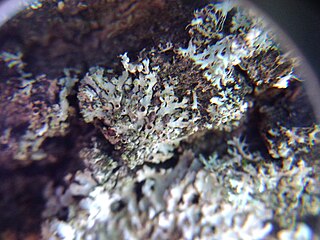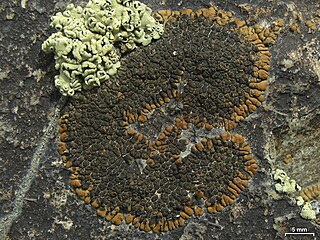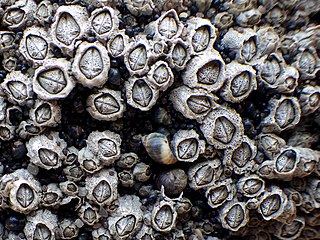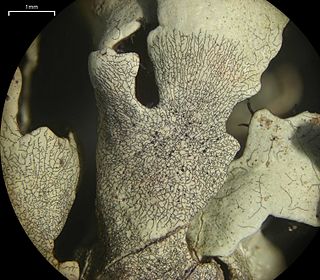
Lichenochora is a genus of fungi in the family Phyllachoraceae. It has 44 species. All species in the genus are lichenicolous, meaning they grow parasitically on lichens. The genus was circumscribed by Josef Hafellner in 1989, with Lichenochora thallina assigned as the type species.

Stigmidium is a genus of lichenicolous (lichen-eating) fungi in the family Mycosphaerellaceae. The genus was circumscribed by Italian botanist Vittore Benedetto Antonio Trevisan de Saint-Léon in 1860, with Stigmidium schaereri assigned as the type species.

Sphaerellothecium is a genus of fungi in the family Phyllachoraceae. All of the species in the genus are lichenicolous, meaning they grow parasitically on lichens.
Endococcus is a genus of lichenicolous (lichen-dwelling) in the family Lichenotheliaceae. It has 44 species. The genus was circumscribed by the Finnish botanist William Nylander in 1855. Although at least one source places the genus in the Verrucariaceae, a 2016 study of the type species, Endococcus rugulosus, determined that it should instead be placed in the family Lichenotheliaceae of the order Dothideales; this classification echoes a placement proposed in 1979 by David Hawksworth.

Xanthopyreniaceae is a family of lichen-forming fungi in the order Collemopsidiales. The family was circumscribed by lichenologist Alexander Zahlbruckner in 1926.
Didymellopsis is a genus of lichenicolous (lichen-dwelling) fungi in the family Xanthopyreniaceae.
Rhymbocarpus is a genus of lichenicolous (lichen-dwelling) fungi in the family Cordieritidaceae. It has 10 species. The genus was circumscribed by German mycologist Friedrich Wilhelm Zopf in 1896, with Rhymbocarpus punctiformis assigned as the type species.

Phacopsis is a genus of lichenicolous (lichen-dwelling) fungi. They are parasites of members of the large lichen family Parmeliaceae, of which they are also a member. Originally proposed by Edmond Tulasne in 1852 to contain 3 species, Phacopsis now contains 10 species, although historically, 33 taxa have been described in the genus. Many of the species are poorly known, some of them having been documented only from the type specimen.

Lichenostigma is a genus of fungi in the family Phaeococcomycetaceae. It includes several species which are lichenicolous. The genus was circumscribed in 1983 by the Austrian mycologist Josef Hafellner, with Lichenostigma maureri assigned as the type species.
Josef Hafellner is an Austrian mycologist and lichenologist. He was awarded the Acharius Medal in 2016 for his lifetime contributions to lichenology. Before his retirement, he was a professor at the Karl-Franzens-Universität in Graz. Hafellner started developing an interest in lichens while he was a student at this institution, studying under Josef Poelt. He earned a master's degree in 1975 and a PhD in 1978, defending a doctoral thesis about the genus Karschia. In 2003, Hafellner received his habilitation. By this time, he had studied with French lichenologist André Bellemère (1927–2014) at Saint-Cloud, where he learned techniques of transmission electron microscopy and how their application in studying asci could be used in lichen systematics. His 1984 work Studien in Richtung einer natürlicheren Gliederung der Sammelfamilien Lecanoraceae und Lecideaceae has been described as "probably the single most influential publication in lichen systematics in the latter half of the 20th century".

Sclerococcum is a genus of lichenicolous fungi in the family Dactylosporaceae.

Polycoccum is a genus of lichenicolous fungi in the family Polycoccaceae. It has about 60 species.
Zwackhiomyces polischukii is a species of lichenicolous (lichen-eating) fungus in the family Xanthopyreniaceae. It occurs in Ukraine, where it parasitises the crustose lichens Bacidia fraxinea and B. rubella.
Crittendenia is a genus of lichenicolous (lichen-dwelling) fungi in the monogeneric family Crittendeniaceae. The genus was circumscribed in 2021 to contain two species, C. lichenicola, and the type, C. coppinsii; these species were previously classified in the genus Chionosphaera. An additional 16 species were added to the genus the following year. The genus name honours British lichenologist Peter Crittenden.
Zwackhiomyces calcariae is a species of lichenicolous fungus in the family Xanthopyreniaceae. It was first formally described in 1896 by French lichenologist Camille Flagey, as Arthopyrenia calcariae. Josef Hafellner and Nikolaus Hoffmann transferred it to the genus Zwackhiomyces in 2000. The fungus is parasitic on lichens in genus Aspicilia.
Protothelenella is a genus of fungi in the family Protothelenellaceae. It contains 11 species, some of which form lichens. Protothelenella species have a crustose thallus with spherical to pear-shaped, dark brown to blackish perithecia. Microscopic characteristics of the genus include bitunicate asci with an amyloid tholus, and ascospores that are colourless and contain multiple internal partitions. Some species grow on acidic substrates including rocks, soil, bryophytes, plant detritus or rotten wood. Other species are lichenicolous (lichen-dwelling), growing on species of Solorina, Peltigera, Pseudocyphellaria, or Cladonia.
Zwackhiomyces echinulatus is a species of lichenicolous (lichen-dwelling) fungus in the family Xanthopyreniaceae. Thus fungus exclusively colonises the lichen species Physconia distorta. This fungus is notable for specific structural features that distinguish it from other members of its genus, and for its niche habitat found only in particular regions of Sicily, Italy.
Zwackhiomacromyces is a genus of lichenicolous (lichen-dwelling) fungi in the family Xanthopyreniaceae. It has two species. The genus is distinguished by its black, pear-shaped fruiting bodies with large, nipple-shaped ostioles that have a granular surface, and a dark, multi-layered wall made up of hyphal cells forming a pseudoparenchymatous structure. The genus is closely related to the similarly named genus Zwackhiomyces.

Perigrapha superveniens is a species of lichenicolous (lichen-dwelling) fungus of uncertain familial placement in the order Arthoniales. It is the type species of the genus Perigrapha. It uses members of the foliose lichen genus Parmelia as its host.








